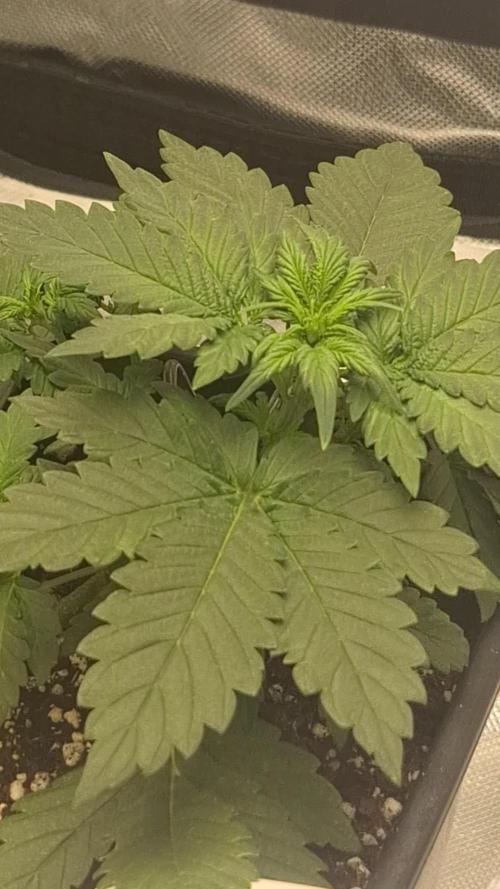The Grow Awards 2026 🏆 



































Likes
Comments
Share


@MadeInGermany
Follow
Hey guys :-)
It's about time that space in the flowering tent becomes available because the ladies are getting extremely bushy and big 👍😂.
was poured this week 2 times with 1 l.
Have fun and stay healthy 🙏🏻💚
👇🏼👇🏼👇🏼👇🏼👇🏼👇🏼👇🏼👇🏼👇🏼👇🏼👇🏼👇🏼
‘Powered by GreenHouse Feeding’
Copy the link for 10% off all Nutrients 👇🏼
http://shop.greenhousefeeding.com/
affiliate/madelngermany_passiongrower/
👇🏼👇🏼👇🏼👇🏼👇🏼👇🏼👇🏼👇🏼👇🏼👇🏼👇🏼👇🏼
You can buy this strain at :
https://www.thegratefulseeds.com/shop/feminized-seeds/original-edition/guava-cake/
Water 💧 💧💧
Osmosis water with 0.0 EC. Add Cal / Mag to 0.4 Ec and Ph - to 6.0 - 6.4
MadeInGermany
Likes
17
Share


@Gorrilla420
Follow
Did abit of chopping this week still abit to go, been looking at expanding this spot to try get few more plants down. Both plants looking healthy, the ny diesel is getting big now, as the cheese has got more closer node spacing. May do abit of lst this week coming as shouldn’t be long before pre flower.
That’s all this week, happy growing 🌱
Processing
Likes
2
Share


@ARAWAK972
Follow
Ça sent la banane trempée dans le fioul ... La Fat Banana Auto et la Royal Gorilla sentent déjà très fort 🤤
Likes
19
Share


@The_Lonely_Farmer
Follow
So this is the end of week 2 flower and these girls are now be entering week 3 with all being fine and healthy these girls are on the stretch 🌱
Ni issues as of yet allthough I did have too move these girls too another property for safety and they have handled the move well with no issues.
Drinking alot now in their coco especially the wedding cheesecake girl where as the 2 orange sherbet at the back are very happy slowly plodding along, on the stretch too as can see.
Scrog did help but as moved these girls it's a few inches tighter so more colpacked but will be lollipopping and defoliating all the scraggly lower bits through this week 3.
Starting too get that hint of smell now too definatley from the orange sherbet I can tel 😍
Stay blessed see you next week 💚
Likes
24
Share


@Kitties_and_Colas
Follow
We gave her a really good flush (we almost never do this btw), and a fresh top dressing of EWC and her color is starting to come back..new growth looks totally healthy.. really wish she wasn't flowering already but it is what it is..
I also decided to show off our Green Crack in the tote, we're planning to veg her for a long time and with luck fill an entire 4x4 tent..
Likes
24
Share


@BunnyBud
Follow
31 Aug. I start the third week of my autoflower. The plant is growing well, but I noticed small yellow spots on the leaf tips, which seem like a mild calcium deficiency. This is probably due to the fact that so far I have been giving water with a slightly low pH, around 6, while the ideal range would be 6.5–7.
At the beginning, to lower the ppm of the tap water (which was around 211 ppm), I mixed it with demineralized water. This brought the ppm down to about 109–140, making it harder for the plant to absorb the available calcium. Additionally, the soil I am using, Biobizz Light Mix, is lightly fertilized but does not contain enough calcium to correct this small initial deficiency.
For this week, I will not add any fertilizers. I simply want to raise the pH to 6.5 and use water with higher ppm, so the plant can better absorb the nutrients already present in the soil.
The lamp is positioned about 35–36 cm from the plant and so far there are no burn issues. Temperatures range between 25 and 30 °C depending on the day, while humidity in the room stays between 40–60%. The humidifier is always on because I keep the window open, but the dehumidifier is not being used, as it is not necessary at the moment.
I also have a new oscillating fan arriving to replace the current fixed one, and I’m waiting for a regulable extractor (90–145 m³/h), which will allow me to control the air perfectly during winter if needed.
This week my main goals are:
Increase the water ppm without overdoing it
Adjust the pH to 6.5
Keep observing the plant without adding any fertilizers
Everything else seems fine and growth is regular. With these corrections, I expect the new leaves to grow healthy and free of spots.
==UPDATE 31/08==
To control the calcium deficiency, I will administer an eggshell solution until I reach 300 ppm (I will boil some eggshells and administer the solution in tap water).
==Update 4 Sept==
By mistake, I adjusted the pH twice, once to 7 and once to 8, and obviously the plant immediately showed symptoms of incorrect pH. At the next watering, I'll give Biobizz Grow with a little Biobizz Bloom since the plant has entered pre-flowering. I'll adjust everything to a pH of 6-7 and a ppm of 450-500.
Likes
3
Share


@MN-Frozen420
Follow
Day 70
Looking good, waiting for Pistols to turn brown.. monster cola's on this one.
Likes
12
Share


@Elemental
Follow
======NOV 4 | DAY 22======
She is a bit different of predominat sativas, leaves are bigger.
Today I increase some humus and some peat.
======NOV 5 | DAY 23======
LST her today
======NOV 8 | DAY 26======
2 more LST HOOKS
======NOV 10 | DAY 28======
I hid some leaves below the main branches
Likes
4
Share


@UnitedStrainsGermany
Follow
Dieses Mal wurden beide defoliert zum letzten Mal vor der Blüte ich werde beide voraussichtlich in einer Woche in die Blüte schicken beide sind sehr potent und sehr gesund !
Likes
5
Share


@Learntogrow818
Follow
Two weeks left, all is good.. Buds pretty dense and smelling great!!!🌱
Likes
8
Share


@sellem
Follow
Done.
Harvested ALL on Day 72 - one LCC was very heavy on amber trichomes, one BPP and one LCC were what i consider optimum, and one BPP was VERY milky, like peak potency. very few amber. Interested to try them all!
Total Drying time was 7 Days for both LCCs and 8 Days for both BPPs.
I decided to do my first proper dry trim. For two plants i hit the spot and could just shave off the remaining leaves. For the other two it was much more of a hassle.
They already smell way better than my previous runs where i dry trimmed. Also the colors are awesome for both plants that purpled.
Smoke review will have to wait some time. Right now, all of them are curing.
Likes
1
Share


@Gumbassman
Follow
Just began flower, smells a little, but coming along, also with hips of bud sites. Some buns from net nut mix.
Likes
35
Share


@SAC87
Follow
Day 63
Well there’s not much going on. Just watering when dry. They seem to be doing better. They are fattening up a bit more and putting on some density. I can tell by the fact that they’re leaning more. This is a 10 wk strain, but I’m gonna push it a bit longer til the trichomes are in a better range.
They have a sweet tropical smell which is quite nice. Not the frostiest buds ever, but we’ll see how it shakes out. The smallest front one is the frostiest of the round.
We’re just on autopilot til the end. Probably a week or 2 more and they’ll be ready to come down.
Happy Growing 🌱
Likes
31
Share


@Ghost2022
Follow
Had a pretty good weer. I have the new carbon fil by Spider farmer. Love it has a temp and hum control built in so i can really leave it undisturbed now. Had a problem with my leaves turning brown and curling. Take a look at the picture and let me know what you think or better still watch my VIDEO. This is Ghost signing out.x ✌️🏻✌️🏻
Likes
9
Share


@TiRobotProds
Follow
Tout se passe bien jusqu'à présent les pistils commencent à sortir j'ai préparé le sol avec des engrais en poudre organique au dernier rempotage. Irrigation a l'eau uniquement. Remplacement de la 400wMh pour 400w SHP.
Likes
54
Share


@BudXs
Follow
"Chugging" along this week. Weather is hot, girls are loving the all time drip system. Forgot that my nutes and hot sun dont mix well and created a bad case of algae. Will monitor more often and maybe increase the drip flow
Processing
Likes
11
Share


@ganjaman24
Follow
My apologies have been away for a bit but the pics are from the last 2 1/2 weeks! Other plant that was the same age turned out to be a male which its unfortunate because it was an accidental cross lol anyway she’s been growing vigourously ever since I made the switch..3 weeks almost complete and she’s a beast! Can’t wait to see the buds form, will try to post more frequently since my scheduled has cleared up some. Thanks for stopping by! Good luck with your own projects!...oh n it may look like I use a lot of nutes but those don’t get used every watering, I often forget to mix or purposely don’t mix one of the supplements but ALWAYS add the 3 base:gro, bloom and micro.
Likes
3
Share


@HowtoBubatz
Follow
The first week of vegetation is here, and it’s been a bit of a mixed start for my two plants.🌱
One of them is looking a little droopy, while the other has developed slightly yellow leaves.
I’m not entirely sure what’s causing these issues, but I’ve decided to give both plants their first dose of nutrients to help prevent further damage and hopefully get them back on track.
I’ve been checking on them daily and keeping a close eye on their progress. I’m staying hopeful that they’ll bounce back and show improvement by next week.🌱





















